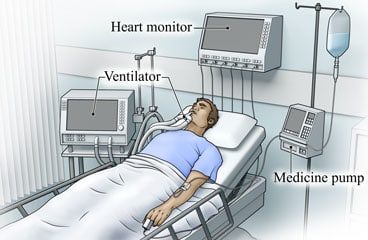What equipment is in the ICU?

An ICU is full of special equipment to keep patients safe and as comfortable as possible. The ICU staff will answer your questions and tell you how the equipment is helping your loved one.
Some machines will beep or display information all the time. Others have alarms on them for emergencies. Ask a member of the ICU staff if you are concerned about the information or alerts on any of the machines.
This is some of the equipment you may see in the ICU.
Breathing equipment
A ventilator is a machine that breathes for a person. It sends oxygen and air into the lungs through a thin tube and allows carbon dioxide to escape. The tube is placed in the windpipe through the nose or mouth.
A continuous positive airway pressure (CPAP) machine may be used when a ventilator isn't needed. It gently pushes oxygen and air into the lungs through a mask over the nose and mouth. People can breathe on their own with this extra help.
A nasal cannula is a plastic tube with two prongs. The prongs are placed in the nostrils when a person just needs more oxygen. The oxygen goes through the tubes and into the nostrils.
Oxygen may also be given through a mask. Oxygen flows through a tube and into a mask that is placed over the nose and mouth.
A tracheostomy, or "trach" (say "trayk"), tube is a breathing tube that goes directly into the windpipe. It is used when a person needs to be on a ventilator for a long time.
Medicine, fluid, and nutrition
An intravenous (I.V.) line is a thin tube placed in avein. It may be placed in the back of the hand, arm, leg, foot, or scalp. One end of a tube is attached to the site. The other end may be attached to a medicine pump.
A central vascular access device (CVAD), or central line, is a long, thin tube that can be placed in the neck, chest, or arm. It is threaded through a vein until it reaches a larger vein near the heart. It can stay in place longer than an I.V. Fluids, medicines, and nutrition can be delivered through the device. Blood samples can be taken through a CVAD.
Medicine pumps can be set to give exactly the right amount of medicine at the right time. The medicine flows through an I.V. site or central line.
Gastrostomy (G-tube) or nasogastric (NG-tube) feeding tubes are used to give nutrients to a person who is unable to eat. These tubes are put directly into the stomach or through the nose into the stomach. They can also remove excess fluids from the stomach or be used to give medicine.
Other equipment
An inflatable cuff on the arm or leg takes blood pressure readings. It sends the data to a blood pressure monitor.
Temperature probes keep track of the person's temperature.
A heart monitor has a sensor that attaches to the chest to track the heart rate and rhythm.
A pulse oximeter clips to the end of the finger. It measures how much oxygen is in the blood.
A urinary catheter drains urine when a person can't go to the bathroom on their own or if the amount of urine needs to be measured.
Where can you learn more?
Go to http://www.healthwise.net/patientEd
Enter L317 in the search box to learn more about "Learning About ICU Equipment".
Current as of: October 1, 2025
Author: Ignite Healthwise, LLC Staff
Clinical Review Board
All Ignite Healthwise, LLC education is reviewed by a team that includes physicians, nurses, advanced practitioners, registered dieticians, and other healthcare professionals.

